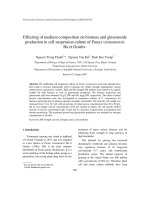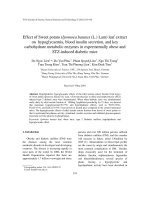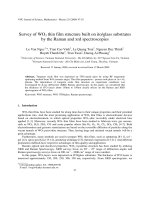Báo cáo " Application of Ground-Penetrating Radar (GPR) and Multi-electrode Resistivity Imaging (MRI) methods to discover old road foundations around Doan Mon vestige " ppt
Bạn đang xem bản rút gọn của tài liệu. Xem và tải ngay bản đầy đủ của tài liệu tại đây (2.68 MB, 10 trang )
VNU Journal of Science, Earth Sciences 23 (2007) 126-135
126
Application of Ground-Penetrating Radar (GPR)
and Multi-electrode Resistivity Imaging (MRI) methods
to discover old road foundations around Doan Mon vestige
Vu Duc Minh
1,
*, Nguyen Ba Duan
2
1
College of Science, VNU
2
Institute of Geophysics, VAST
Received 07 February 2007
Abstract. Archaeological Institute and Department of Culture and Information of Hanoi have
made archaeological excavations inside Doan Mon vestige. As a result, at the depth of 1.0-1.2m an
yard covered by the brick, stone jetty of the Le Dynasty; at the depth of 1.9-2.0m the 1.3m-wide
road, covered by the lemon flower-colour brick, of the Tran Dynasty, below it is old road
foundation of the Ly Dynasty have been found. With this information, we have investigated in
order to get information for determining these old road foundations around Doan Mon vestige in
the direction of old road foundations found inside Doan Mon vestige.
With the obtained results, it can be seen that application of the combination of Ground-
Penetrating Radar (GPR) and Multi-electrode Resistivity Imaging (MRI) methods can fully satisfy
the requirements of archaeologists in solving archaeological problems. Due to non-destructive
feature, fast investigating speed, with less time and low cost, the application of these methods can
help archaeologists to quickly observe a whole picture of the area under investigation. The old
foundation layer and the old road are shown rather clearly and continued to extend from Doan
Mon Gate to Kinh Thien Temple. Beside, we have discovered small objects scattered on different
profiles.
Keywords: GPR; MRI; Profile; Section; Antennae.
1. Introduction
*
The archaeologists always have difficulties
in locating and mapping archaeological objects
buried in the great depths and having no or very
few signs on the ground surface. When facing
that problem, they often have to randomly carry
excavation until they obtain more statistical
features of the drilled samples, the expected
_______
*
Corresponding author. Tel.: 84-4-8587781.
E-mail:
signs or from the excavation.
Ground-Penetrating Radar (GPR) and
Multi-electrode Resistivity Imaging (MRI) are
the near earth surface geophysical methods
used for investigation of geological structures,
geotechnics, geoenvironment or finding objects
(natural or artificial) buried in the ground.
Both of these methods support each other
very effectively in solving archaeological
problems. Due to non-destructive feature, fast
investigating speed, low cost, the application of
Vu Duc Minh, Nguyen Ba Duan / VNU Journal of Science, Earth Sciences 23 (2007) 126-135
127
these methods can help archaeologists to
quickly observe a whole picture of the area
under investigation, these geophysical methods
are accepted by the archaeologists as a part of set
of archaeological methods. This is archaeological
geophysics.
In the world, the archaeologists have used
very successfully archaeological geophysical
methods for archaeological works in Pyramids
(Egypt), sepulchral vaults in Valencian Church,
Maria Rossa Church (Italia),
In our previous work, we have reported on
preliminary results of our attempts to use a
combination of GPR and MRI methods for
searching and finding old vestiges buried in the
ground. In this paper, we present some results
in discovering old road foundation around
Doan Mon vestige buried in the ground using
the combination of GPR and MRI methods.
2. Methods and equipments
At present, due to wide applicability of GPR
and MRI methods, many modern equipments
are made by different manufacturers. In this
investigation, GPR equipment [1, 2] used is SIR
10B equipment (Fig. 1), Geophysical Survey
System Inc. (GSSI) with 80 MHz, 200 MHz, and
400 MHz antennae and MRI equipment [3] is
SuperSting R1 (Fig. 2), Advanced Geoscience
Inc. (AGI). Both these equipments are made in
USA and have very powerful software suites.
2.1. GPR method
GPR method uses electromagnetic waves
with frequencies from 1 to 1500 MHz. At each
measuring point, GPR system generates a high-
frequency electromagnetic pulse through
antenna to the environment under investigation.
When meeting the objects with differences in
electrical properties, this pulse will be reflected
back to the ground and received by receiving
antenna. The data will be transformed to
computer for saving, displaying and analysing
by software.
When the system is moving on the profile,
continuous generating and receiving processes
make a picture of environment under
investigation on the screen (wave pattern) (Fig.
3). The differences in electrical properties of the
objects in environment are closely related to
their petrographic composition, mechanico-
physical properties, formation conditions and,
as far as archaeology is concerned, these are
structure of the vestiges, objects buried in the
ground etc. Target resolution and investigating
depth depend on antenna frequencies used.
a. Control unit of equipment SIR 10B b. Investigation by 400 MHz antenna
Fig. 1. Equipment SIR 10B.
Vu Duc Minh, Nguyen Ba Duan / VNU Journal of Science, Earth Sciences 23 (2007) 126-135
128
a. Measuring unit SuperSting R1 b. Arrangement of electrodes on the profile
Fig. 2. Equipment SuperSting R1.
Fig. 3. Scheme describing operating principles of ground-penetrating radar method.
2.2. MRI method
MRI method determines electrical
conductivity of the environment by using two
electrodes generating currents C1, C2 to the
ground surface and measures voltage between
two receiving electrodes P1, P2. By placing
many couples of electrodes with different
arrangements on one profile (Fig. 4a) and by
fully automatic control and storage, we
determine the resistivity distribution of the
environment on that profile. Based on the
differences in resistivity, by using the software
algorithms we determine the objects with
different features. The results of profile
measurements are displayed in 2D form called
pseudoresistivity cross-section (Fig. 4b).
Vu Duc Minh, Nguyen Ba Duan / VNU Journal of Science, Earth Sciences 23 (2007) 126-135
129
Fig. 4. Arrangement of electrodes on the profile, measuring process recording data
to establish pseudoresistivity cross-section of the MRI method.
3. Arrangement of investigation profiles
In 1999, Archaeological Institute and
Department of Culture and Information of
Hanoi made archaeological excavations inside
Doan Mon vestige. As a result, many valuable
relics have been discovered. Especially, at the
depth of 1.0-1.2m an yard covered by the brick,
stone jetty of the Le Dynasty (XV - XVIII
century) have been found. At the depth of 1.9-
2.0m the 1.3m-wide road, covered by the lemon
flower-colour brick, of the Tran Dynasty (XIII -
XIV Century) has also been found, below it is
old road foundation of the Ly Dynasty (XI-XII
Century). With this information, we have
investigated in order to get information for
determining these old road foundations around
Doan Mon vestige in the direction of old road
foundations found inside Doan Mon vestige.
We have placed the measuring profiles
coinciding with or perpendicular to the
directions of old road foundations found inside
Doan Mon vestige, from Doan Mon gate to
Kinh Thien Temple. In these profiles, the MRI
measuring profile with distance of 1m between
the electrodes is profile DIEN-1 just behind
Doan Mon gate and in front of the house N6
and a plenty of GPR measuring profiles with
antennae of 80 MHz (denoted as 80, for
example 80D2), of 200 MHz (denoted as 2, for
example 2D1) and of 400 MHz (denoted as 4,
for example 4D2). These profiles are presented
in Fig. 5.
(
a
)
(b)
Vu Duc Minh, Nguyen Ba Duan / VNU Journal of Science, Earth Sciences 23 (2007) 126-135
130
Fig. 5. Position scheme of geophysical investigating profiles.
4. Results of analysis
In the study area, many GPR profiles were
located in South - North as well as East – West
directions and one MRI profile (DIEN-1). We
only present some typical results from many
obtained ones.
Fig. 6 shows the 80 MHz-antenna GPR
sections in the area. On the East - West profiles,
we observed some but not clear signs of
foundation layer (marked rectangle). In the
wave pattern of two profiles 80D2L1 and 80D3
which are rather closed to each other and very
near the surrounding wall of Doan Mon
vestige, there is a manifest of rather large
abnormal object on the foundation area.
However, on the South - North profile 80N2L1
crossing them manifest has not been observed.
Therefore, it is very difficult to gather what
object causes this anomaly. On the East - West
profiles there is also sign of underground water
- level (triangle) at the depth of about 2.2-2.5m
but on the South - North profiles this sign is not
seen. At this depth we observed only a sign of
fundament layer. Thus question is whether this
sign is due to foundation layer at depth of about
2m or not? However, it is difficult to explain
because this antenna often gets disturbance,
especially from the objects on the surface. On
the profiles there are also signs of geological
structures at the depth of 2.5m as well as large
abnormal objects, sullage pit, etc.
Using 80 MHz-antenna South - North and
East - West profiles in the area, we have
established the 3D picture across these GPR
sections. As one can see in Fig. 7, sign of old
foundation layers at the depth near the ground
surface can be seen if looking from Doan Mon
side. However, there is a little sign in the part of
house N6. In the 3D pictures we clearly observe
sign of old foundation layer at the depth of 2m
(or underground water - level?) and the
geological structures.
Fig. 8 presents the wave pattern of profiles
coinciding with each other but with different
lengths and depths, showing that the signs
from them are nearly the same. On the GPR
section 8D1, we see that at distance of 10
th
geological structure has a hill shape and at both
sides of it there are horizontal reflections having
a sign of underground water - level rather than
foundation layer since these are strong reflections
and depth is of about 2.5m.
Vu Duc Minh, Nguyen Ba Duan / VNU Journal of Science, Earth Sciences 23 (2007) 126-135
131
Fig. 6. The 80 MHz-antenna GPR sections along East - West (right) and South - North (left) profiles
in the area behind Doan Mon Gate.
Fig. 7. The 3D pictures across the 80 MHz-antenna South - North and East - West profiles
in the area behind Doan Mon Gate.
Vu Duc Minh, Nguyen Ba Duan / VNU Journal of Science, Earth Sciences 23 (2007) 126-135
132
Fig. 8. Comparison of the East - West profiles coinciding with each other
but with different lengths and depths 8D1 and 80 D2.
Fig. 9 shows the wave pattern of 200 MHz-
antenna profiles. On both GPR sections,
foundation layer at the depth of 2m has a sign,
but because above part has a plenty of
abnormal objects, the signal is spread out. The
end of both two GPR sections crosses sewer and
water pipes. The wave pattern of the profile
2D2 has also a sign of road foundation at the
depth of 1.2m, at both sides of that there are
two stone jetties, at distance from 6
th
to 9
th
. This
sign is rather clear with 400 MHz-antenna GPR
sections (Fig. 10).
Fig. 10 presents the wave pattern of 400
MHz-antenna profiles. With these frequencies
many abnormal objects have been found. On
the profile 4D1 just at the wall, the foundation
layer at the depth of 1m is clearly seen.
Especially at distance from 7
th
to 9.5
th
there is a
sign of two stone jetties. This can be a sign of
the road of the Le Dynasty. On this profile, the
foundation layer at the depth of 2m has no any
sign. On the profile 4D2 the foundation layer at
the depth of 1m is not clear but sign of the stone
jetty is rather clear at distance from 8
th
to 10.5
th
.
On this GPR section the foundation layer at the
depth of 2m has a sign at the beginning the
GPR section. Thus may be the foundation layer
at the depth of 2m exists but the signal is
diminished due to the abnormal objects above it.
The relative comparison of the profile of the
multi-electrode resistivity imaging DIEN-1
and the radar profile 4D2 nearby is shown in
Fig. 11. We can see that the marked area can be
a sign of road foundation at the depth of about
1.2m at distance from 10.5
th
to 14
th
. Besides, on
the profile DIEN-1 an object of large resistivity
has been found at the distance of 17
th
at the
depth of about 1m. The part above this cross-
section has rather high resistivity, the part
below has smaller resistivity and has structure
canted to the direction to the end of the profile
(compare with 80 MHz-antenna cross-sections
GPR).
Vu Duc Minh, Nguyen Ba Duan / VNU Journal of Science, Earth Sciences 23 (2007) 126-135
133
Fig. 9. Results of analysis for 200 MHz-antenna GPR sections: profile 2D1 (above),
2D jointed picture of two profiles (middle) and profile 2D2 (below).
Vu Duc Minh, Nguyen Ba Duan / VNU Journal of Science, Earth Sciences 23 (2007) 126-135
134
Fig. 10. Results of analysis for 400 MHz-antenna GPR sections: profile 4D1 (above),
profile 4D2 (middle) and 2D jointed picture of two profiles (below).
Fig. 11. Results of analysis for the multi-electrode resistivity imaging profile DIEN-1
in comparison with the nearby located radar profile 4D2.
Vu Duc Minh, Nguyen Ba Duan / VNU Journal of Science, Earth Sciences 23 (2007) 126-135
135
5. Conclusions and recommendations
1. The presented results suggest that whole
investigated area can locate on not high hill and
is a sign of cultural layers at the depth of about
1m and 2m on many 200 MHz and 400 MHz-
antenna GPR sections. The foundation layer at
the depth of 1m and the old road are shown
rather clearly through stone jetties on both sides
and continued to extend from Doan Mon gate
to Kinh Thien Temple. The foundation layer at
the depth of 2.0-2.5m has not much been signed
but exists on many GPR sections. However, at
this depth it can be confused with underground
water - level. Beside, we have discovered small
objects scattered on different GPR sections.
However, because the purpose of this
investigation is to discover old road foundation
around Doan Mon vestige, we do not pay much
attention to these objects at present.
2. The methods used in this investigation
are standard ones among the geophysical
archaeological methods used nowadays in the
world due to notable advantages such as fast
investigating speed, compact, non-destructive,
high resolution and especially these two
methods support each other very effectively in
the conditions of our country.
3. With the pointed purpose, the selection of
the existing GPR and MRI equipments in
Vietnam can fully satisfy the requirements of
the archaeologists in determining the location
as well as the nature of archaeological objects in
overall, quickly, with less time and lost cost.
4. Although the application of these methods
to discover old vestiges in Vietnam is completely
new, thus we do not have much experience in
selecting relevant types of antenna with respect
to the GPR method and combine in the best
way two GPR and MRI methods, the preliminary
results are good and promising.
5. As far as the GPR method is concerned,
for the archaeological problems we suggest to
select antenna with frequencies of 200-500 MHz.
Before investigation, it is necessary to determine
optimal investigating parameters and arrange
the system of the profiles so that 3D picture of
the area under investigation can be established.
When a couple of antennas is moved on the
ground surface (Fig. 2b), we have a 2D picture
(East - West cross-section) of reflections. When
making many South - North and East - West
cross-sections at closed distance, we will get
“block” of 3D data of the environment for
processing and establishing the 3D picture.
Another important issue is one should be able
to determine the wave propagation velocity of
the environment under investigation. Only then
the depth to an object is correct. On the other
hand, in order to increase the effectiveness of
the application, there should be coordination
with the archaeologists. We are continuing to
study in more details, and the better results are
expected to publish elsewhere.
Acknowledgements
The authors would like to thank Architect
Le Thanh Vinh, Director of Institute for
Conservation of Monuments, Ministry of Culture
and Information, and the staff members Pham
Hoai Nam, MSc. Ta Quoc Khanh for assistance
in entering a new field of application of geophysical
methods in archaeological work. We also express
our thanks to MSc. Trinh Van Hanh, Director of
Centre for Termite Control Research, Institute
of Water Resources Research, and staff of the
centre for their help in field measurements.
References
[1] L. B. Conyers, D. Goodman, Ground Penetrating
Radar: An Introduction for Archaeologists, Altamira
Press, Walnut Creek, California, U.S.A, 1997.
[2] N. Stewart, H. Griffiths, Ground Penetrating Radar,
2
nd
edition, MPG Books Limited, Bodmin, Cornwall,
UK, 2004.
[3] J.H. Cogon, A comparison of electrode arrays,
Geophysics 38 (1973) 737.









